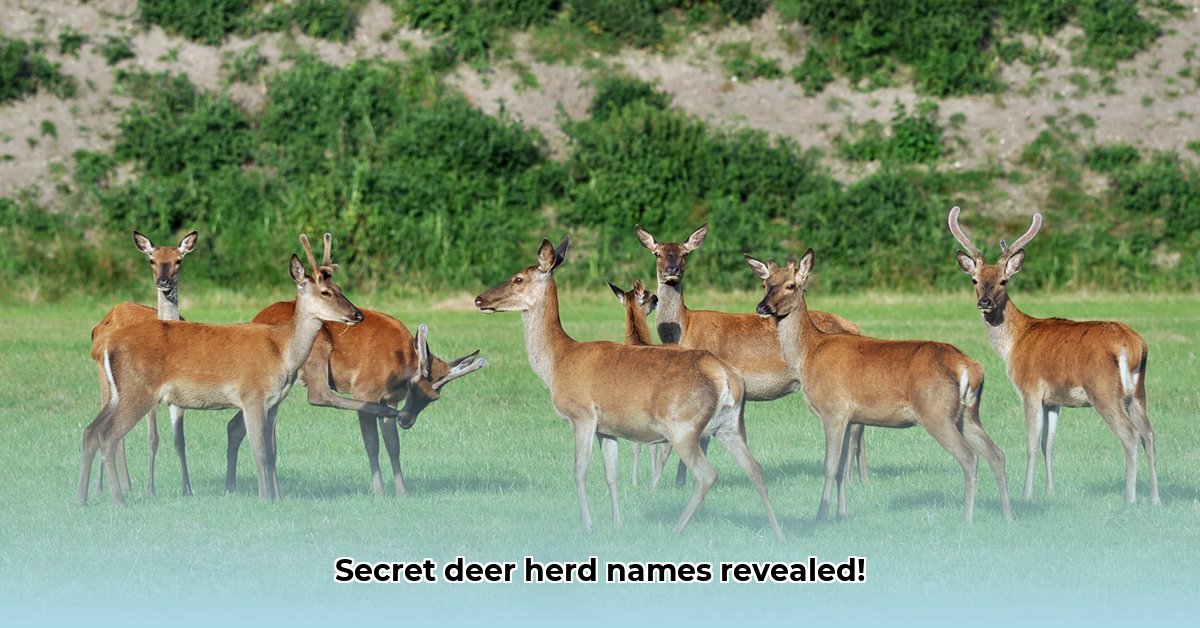
Deer Herd Names: Beyond the Basics
Have you ever wondered about the precise language used to describe a group of deer? It's more than just a simple "herd"—the terminology is surprisingly nuanced, reflecting the complex social structures and behaviors of these magnificent creatures. This guide will equip you for choosing the right term, whether you're writing a scientific report, crafting a nature story, or simply engaging in casual conversation. Understanding these nuances elevates your communication and deepens your appreciation for the natural world. For even more deer group names, check out this helpful resource: Deer group names.
Unpacking the Factors That Shape Our Deer Group Descriptions
Selecting the appropriate collective noun for a group of deer depends on several key factors. Simply using "herd" may be accurate in some cases, but it lacks the precision and descriptive power offered by more nuanced terms.
Deer Species: The social behaviors of different deer species vary greatly. For example, white-tailed deer exhibit different social dynamics compared to mule deer, necessitating distinct terminology. A solitary species will rarely be described as a "herd."
Group Size: The size of the deer aggregation directly impacts the appropriate term. A small family group differs dramatically from a massive seasonal migration. Would you describe a small family gathering as a "mob"? Likely not.
Age and Gender Composition: A group of adult male deer (bucks) behaves differently from a group of females (does) and their young (fawns). The age and sex makeup of the group significantly influences the most fitting collective noun. Bucks, particularly, often display more solitary behavior outside of breeding season.
Seasonal Variations: Deer behavior is influenced by the season. The rut (mating season), winter, and summer all dramatically affect group dynamics and activity, thereby shaping the most accurate descriptive term. Think of the difference between a dispersed summer group and a tightly-knit winter herd.
Activity Level: The deer's current behavior – whether calmly grazing, fleeing from a predator, or actively migrating – substantially influences the most suitable collective noun. A peaceful grazing group differs markedly from a panicked, fleeing mob.
Beyond the Herd: A Comprehensive Guide to Deer Group Terminology
The term "herd" is widely applicable, but several other collective nouns offer greater precision and descriptive power:
| Collective Noun | Description | Example |
|---|---|---|
| Herd | The most common term, suitable for large, mixed-sex groups of various ages. | "A large herd of white-tailed deer grazed peacefully in the meadow." |
| Bevy | Typically refers to a smaller group of female deer, often with young (fawns). | "A bevy of does and fawns sought shelter under the trees during the afternoon thunderstorm." |
| Parcel | A smaller, more tightly knit group; often implies a family unit or close-knit group. | "A small parcel of deer browsed near the creek, their movements synchronized and deliberate." |
| Gang | Often suggests a group of male deer, possibly exhibiting dominance or aggression. | "A gang of bucks sparred playfully, their antlers clashing rhythmically." |
| Mob | Implies a large, possibly agitated or frightened group; often fleeing from danger. | "A mob of deer thundered through the woods, escaping the approaching wildfire." |
| Run/Drove | Large groups in motion, often migrating or traveling long distances. | "A drove of deer migrated across the plains in search of better grazing lands." |
"Did you know that the choice of collective noun can dramatically alter the reader's perception of a scene?" asks Dr. Emily Carter, Wildlife Biologist at the University of Colorado Boulder. "Using precise terminology is crucial for effective communication, particularly in scientific reporting and nature writing."
Mastering the Art of Deer Group Description: Practical Application
The skillful application of diverse collective nouns transforms your writing from generic to engaging. Consider these examples:
- Generic: "A herd of deer crossed the road."
- Evocative: "A bevy of does and their fawns daintily crossed the road, their movements graceful and synchronized."
The latter description paints a far richer, more detailed picture, showing a deeper understanding of deer behavior and social dynamics. This level of precision is vital in any context, enhancing the reader's engagement and appreciation for nature's intricacies. Remember to consider the context, audience, and intended mood when selecting your collective noun.
Key Takeaways: Precision in Deer Group Terminology
- The choice of collective noun depends on species, group size, age/sex composition, seasonality, and the deer's current activity.
- While "herd" is widely used, more specific terms provide richer and more accurate descriptions.
- Mastering this terminology enhances writing quality and showcases a deeper understanding of deer behavior.
- Consider the audience and desired tone when selecting a collective noun.
This guide empowers you to communicate about deer groups with precision and evocative power, deepening your engagement with the natural world.